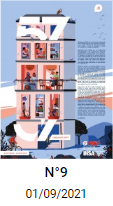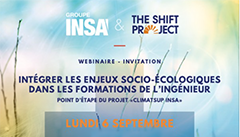
INSA Lyon
Intégrer les enjeux socio-écologiques dans les formations de l'ingénieur
Point d'étape.
Initié en septembre 2020, le projet « ClimatSup INSA » vise à intégrer les enjeux socio-écologiques au cœur de toutes les formations du Groupe INSA. Après un rapport intermédiaire présenté au grand public en février 2021, The Shift Project et le Groupe INSA proposent un nouveau point d’étape afin de présenter l’avancement du projet et les suites à venir.
Additional informations
- https://www.insa-toulouse.fr/fr/webinaire-point-d-etape-du-projet-climat-sup-insa.html
-
Webinaire sur Zoom et retransmission live Facebook
Keywords (tags)

Entreprises
Jeunes diplômés : comment avancent-ils dans la tempête Covid ?
L'entrée dans la vie active est une étape clé du parcours d’étudiant souvent ponctué de nombreux questionnements et de doutes. Comment faire vivre les enseignements reçus dans leur nouvelle vie de jeune actif ? Trouver sa voie et se projeter sur l’avenir n’est pas toujours facile dans un monde en perpétuelle évolution. Dans le contexte de crise sanitaire que le monde connaît actuellement, les questionnements semblent être exacerbés pour les jeunes diplômés. Entre un marché du travail en crise et un pessimisme perpétuel des médias, comment vit-on sa vie de jeune diplômé INSA en 2020 ?
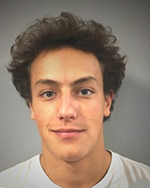 Si le passage du quotidien d’étudiant aux premiers pas dans la vie active représentait déjà une période de chamboulement important pour un jeune diplômé, le contexte Covid ne semble pas faciliter la transition. Récemment diplômé du département informatique, Grégoire Bailly déplore le manque d’opportunités et de rencontres sur lesquelles leurs camarades des promotions précédentes avaient pu compter. « Je suis un peu frustré de ne pas pourvoir me lancer pleinement dans la découverte de nouveaux horizons professionnels. J’ai réalisé mon stage de fin d’études en télétravail, donc pour commencer à se construire un réseau, les possibilités étaient limitées », explique Grégoire.
Si le passage du quotidien d’étudiant aux premiers pas dans la vie active représentait déjà une période de chamboulement important pour un jeune diplômé, le contexte Covid ne semble pas faciliter la transition. Récemment diplômé du département informatique, Grégoire Bailly déplore le manque d’opportunités et de rencontres sur lesquelles leurs camarades des promotions précédentes avaient pu compter. « Je suis un peu frustré de ne pas pourvoir me lancer pleinement dans la découverte de nouveaux horizons professionnels. J’ai réalisé mon stage de fin d’études en télétravail, donc pour commencer à se construire un réseau, les possibilités étaient limitées », explique Grégoire.
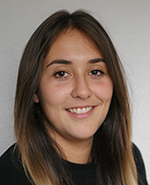 En 2019, 67% des étudiants stagiaires avaient été recrutés avant leurs diplomations. Certains diplômés espéraient pouvoir compter sur cette tendance pour assurer leur insertion sur le marché du travail. Malheureusement pour Manon Anekkar, diplômée de génie mécanique, la réalité économique de son entreprise en a décidé autrement. « Après mon stage, je me suis laissée une semaine de pause pour souffler un peu et prendre un peu de recul sur la situation que nous étions en train de vivre. Mais dès le début de mes recherches, j’ai rapidement compris que les opportunités étaient moins nombreuses qu’à l’accoutumé. En attendant, je trouve du soutien auprès de mon entourage et je ne baisse pas les bras. Je compte sur le souffle qu’apportera la nouvelle année pour m’insérer dans la vie active », dit-elle.
En 2019, 67% des étudiants stagiaires avaient été recrutés avant leurs diplomations. Certains diplômés espéraient pouvoir compter sur cette tendance pour assurer leur insertion sur le marché du travail. Malheureusement pour Manon Anekkar, diplômée de génie mécanique, la réalité économique de son entreprise en a décidé autrement. « Après mon stage, je me suis laissée une semaine de pause pour souffler un peu et prendre un peu de recul sur la situation que nous étions en train de vivre. Mais dès le début de mes recherches, j’ai rapidement compris que les opportunités étaient moins nombreuses qu’à l’accoutumé. En attendant, je trouve du soutien auprès de mon entourage et je ne baisse pas les bras. Je compte sur le souffle qu’apportera la nouvelle année pour m’insérer dans la vie active », dit-elle.
 À l’inverse de Manon, d’autres de ses camarades ont été plus chanceux. Quentin Bulot, diplômé du département génie énergétique et environnement a choisi la sécurité quand son entreprise d’accueil lui a proposé un CDI. « Lorsque j’étais étudiant, je m’imaginais me laisser le temps de découvrir plusieurs secteurs et entreprises différentes avant de poser mes valises. Pour tout avouer, la crise sanitaire a fait changer mon fusil d’épaule, et j’ai préféré jouer la carte de la sérénité avec un contrat à durée indéterminée », explique-t-il.
À l’inverse de Manon, d’autres de ses camarades ont été plus chanceux. Quentin Bulot, diplômé du département génie énergétique et environnement a choisi la sécurité quand son entreprise d’accueil lui a proposé un CDI. « Lorsque j’étais étudiant, je m’imaginais me laisser le temps de découvrir plusieurs secteurs et entreprises différentes avant de poser mes valises. Pour tout avouer, la crise sanitaire a fait changer mon fusil d’épaule, et j’ai préféré jouer la carte de la sérénité avec un contrat à durée indéterminée », explique-t-il.
 Si certaines entreprises restent prudentes sur les embauches, d’autres misent sur l’avenir et les compétences fraîchement acquises. C’est le cas pour Tanguy Keryhuel, ingénieur en génie industriel. Après un stage au sein d’un grand groupe de l’industrie du luxe, le diplômé INSA s’est vu proposé un contrat d’alternance doublé d’un financement pour réaliser un mastère spécialisé en management de projets et programmes. « C’était une superbe opportunité qui ne se refuse pas, surtout quand l’emploi paraît si incertain à l’extérieur. Moi qui ai toujours eu le regard tourné vers l’international, j’attends que les conditions sanitaires nous permettent à nouveau de voyager car mon entreprise propose des mobilités à l’étranger. C’est la seule chose que j’ai dû mettre en suspend à cause du Covid », dit-il.
Si certaines entreprises restent prudentes sur les embauches, d’autres misent sur l’avenir et les compétences fraîchement acquises. C’est le cas pour Tanguy Keryhuel, ingénieur en génie industriel. Après un stage au sein d’un grand groupe de l’industrie du luxe, le diplômé INSA s’est vu proposé un contrat d’alternance doublé d’un financement pour réaliser un mastère spécialisé en management de projets et programmes. « C’était une superbe opportunité qui ne se refuse pas, surtout quand l’emploi paraît si incertain à l’extérieur. Moi qui ai toujours eu le regard tourné vers l’international, j’attends que les conditions sanitaires nous permettent à nouveau de voyager car mon entreprise propose des mobilités à l’étranger. C’est la seule chose que j’ai dû mettre en suspend à cause du Covid », dit-il.
Conscients du monde et du contexte dans lequel ils évoluent, les insaliens diplômés sont nombreux à évoquer l’importance de croire en l’avenir. Le jeune diplômé d’informatique Grégoire Bailly ajoute : « J’ai confiance en mon domaine de spécialité. La crise que nous traversons a déjà montré l’impérieuse nécessité de l’informatique, mais aussi ses limites, alors je ne suis pas très inquiet. La société d’aujourd’hui a besoin d’ingénieurs spécialisés en informatique pour résoudre les problématiques soulevées par la crise ».
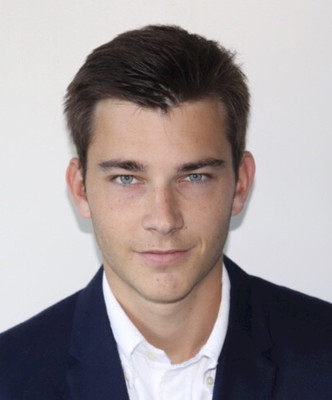 D’autres ont préféré mettre leur raison de côté, pour se laisser guider par les choix de leurs cœurs. Martin d’Agay et Vincent Garcia se sont lancés dans l’aventure entrepreneuriale tout juste après leur diplomation en génie industriel en 2019. Le premier confinement avait été déclaré quelques mois après la création de leur start-up, Kikleo. « Nous avons développé notre projet au sein de la filière étudiant entreprendre pendant nos études à l’INSA. Notre défi est de réduire le gaspillage alimentaire en développant une solution à destination de la restauration collective. Manque de chance, notre outil s’est rapidement confronté aux mesures barrières édictées par le gouvernement. Il est clair que nous n’avions pas prévu de devoir faire face si rapidement à une tempête de cette envergure avec notre entreprise, mais nous avions décidé de relever le défi. Et aujourd’hui, nous avons pu embaucher deux stagiaires », explique Martin.
D’autres ont préféré mettre leur raison de côté, pour se laisser guider par les choix de leurs cœurs. Martin d’Agay et Vincent Garcia se sont lancés dans l’aventure entrepreneuriale tout juste après leur diplomation en génie industriel en 2019. Le premier confinement avait été déclaré quelques mois après la création de leur start-up, Kikleo. « Nous avons développé notre projet au sein de la filière étudiant entreprendre pendant nos études à l’INSA. Notre défi est de réduire le gaspillage alimentaire en développant une solution à destination de la restauration collective. Manque de chance, notre outil s’est rapidement confronté aux mesures barrières édictées par le gouvernement. Il est clair que nous n’avions pas prévu de devoir faire face si rapidement à une tempête de cette envergure avec notre entreprise, mais nous avions décidé de relever le défi. Et aujourd’hui, nous avons pu embaucher deux stagiaires », explique Martin.
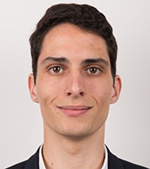 En dépit de la fermeture des restaurants collectifs, Kikleo s’est adapté et a grandi avec ses fondateurs. « Nous avons tout de même essayé de tirer le meilleur de ce confinement car nous avons continué nos tests à la maison, réfléchi à la suite et développé de nouvelles idées. Se lancer dans l'entrepreneuriat à notre âge est déjà un défi, et gérer une entreprise en période de crise, l’est encore plus. Nous avons tiré beaucoup d’enseignements de tout cela, et d’ailleurs peut-être le plus important : celui d’y croire profondément », confie Vincent.
En dépit de la fermeture des restaurants collectifs, Kikleo s’est adapté et a grandi avec ses fondateurs. « Nous avons tout de même essayé de tirer le meilleur de ce confinement car nous avons continué nos tests à la maison, réfléchi à la suite et développé de nouvelles idées. Se lancer dans l'entrepreneuriat à notre âge est déjà un défi, et gérer une entreprise en période de crise, l’est encore plus. Nous avons tiré beaucoup d’enseignements de tout cela, et d’ailleurs peut-être le plus important : celui d’y croire profondément », confie Vincent.
Si le contexte sanitaire a apporté son lot de complications, les six jeunes diplômés restent confiants et optimistes. Dans une société chamboulée par une crise sans précédents, ils portent haut les valeurs humanistes de leur école.
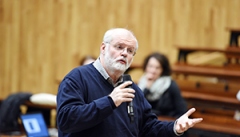
INSA Lyon
INSA engineer, philosopher in action
The role of engineers and their future are at the heart of a process of reflection being undertaken at INSA Lyon with its entire ecosystem. Scientific Co-Director of the Chair ‘Ingénieur.e INSA, philosophe en action. Penser et agir de manière responsable (Thinking and acting responsibly)’, Michel Faucheux, former director of the Humanities Centre at INSA Lyon, a man of letters, sheds light on the context in which this research work is emerging, useful for engineers and the world of tomorrow.
The creation of the chair ‘Ingénieur.e INSA, philosophe en action. Penser et agir de manière responsable’ is in line with the legacy of the philosopher Gaston Berger, one of the founders of INSA Lyon. Although the educational project of training an engineer1 in direct contact with society and its technological, social and economic issues remains relevant, the fact remains that times have changed and we are no longer in the ‘Trente Glorieuses’.
The Chair aims to update and rethink the INSA engineering model while remaining faithful to a heritage that gives our school a strong historical, philosophical and educational identity, which is what makes it unique in the field of French engineering schools. In a conference speech on 8 March, 1955, Gaston Berger described company directors as ‘philosophers in action’, ‘having become aware not only of the complexity of problems, but also of the duties that are imposed on them and that give them an ethical role’. More than ever, to meet the unprecedented challenges facing us, engineers, engaged in technical ‘businesses’ and often company directors themselves, must assume the role of ‘philosophers in action’, guided by a love of a combination of (technical) knowledge and wisdom to guide their actions and make them capable of rebuilding a more humane world.
For the task before us is a huge one, quite different from that of engineers educated in the 1960s, the driving force behind economic growth and well-being that benefited a France shaken and impoverished by the war years.
Two decades ago, we entered a new world produced by an accelerated and radical technological revolution, which some call ‘disruption’. This artificial, digitised, interconnected, virtualised, globalised, multicultural world is shaking up the relationship of human beings with themselves as well as with society, nature and other living beings. The old oppositions that anchored us in a stable relationship with the world have been shattered: true and the false, real and virtual/artificial, man and machine, me and others, here and elsewhere, inside and outside... While our opportunities for action have increased tenfold.
If ‘the world before’ was stable, solid, based on a foundation of guaranteed practices, certainties and representations, this new world where one can surf for all kinds of knowledge and where information circulates at full speed is a ‘fluid’ world, fluctuating, tempestuous, characterised by turmoil, disorder, crisis and the unexpected.
This is what we are currently experiencing: a pandemic that has immobilised a large part of the planet and is linked to a major ecological crisis which, caused by the accelerated destruction of species and global warming, is endangering humanity. The phenomenon of crisis is no longer occasional. It has become structural, the constituent element of our world, taking on several interrelated dimensions: ecological, social, societal, economic and political.
In this new context, the aim of the Chair is to help educate engineers, ‘philosophers in action’, who are not only able to deal with crises and storms but creative and ingenious, cutting across different areas of knowledge to think about technology at a time when the knowledge map is changing. This will also lead us to our destination: a diverse, viable and sustainable world order that engineers will have helped to build. This is not a mere utopia, for there is an urgent need to move towards an economic and social system that recognises the finiteness of the earth's resources and puts technology, freed from the dreams of all power and unlimited profit, at the service of humanity, building a new alliance between human beings and nature but also solidarity between human beings, cultures and societies. Finally, it integrates aesthetic concerns into everyday life.
There has never been such a challenge in the history of mankind because, for the first time, we are talking about the survival of our species and the viability of human constructions. At the end of this long period of lockdown, ‘the time has come’, as many now say, to rebuild a future. There have been builders of monuments of all kinds and major political and social projects... There is now a need for builders of the future. And we believe that ‘the INSA engineer, philosopher in action’, to be faithful to his or her history, must be one of those builders of the future, made up of a mix of technology and wisdom, built on resistance to injustice, inequality and the unacceptable.
But the future cannot be built without the experience of those already engaged in action. This is why the Chair, which is open to the INSA community from which it emanates, thanks to a co-construction approach, will draw on the practical experience of alumni to analyse how we can deploy a responsible mode of action in the company and society, and develop everyday ethics and ‘wisdom’ of action beneficial to all. It will be based on the strength of testimony, feedback and analysis of debates generated by, for example, decision, action and implementation.
The only great projects are those driven by a shared memory and vision. But there are also moments when the storm that sweeps away history can metamorphose into a breath of fresh air towards the future. Caught between a major technological revolution and a radical ecological crisis, we are living at a time that requires us not to look away from ‘our burning house’ but to resist and fight the destructive approaches that threaten the construction of a sustainable world.
We should not be afraid of ambitious projects. The creation of the INSA alternative model was itself an ambitious project. This is why, in the end, I wonder if the project of this Chair is limited to supporting the education of an ‘engineer, philosopher in action’, a bearer of humanist and responsible values - which is already a lot! Perhaps it is much more than that: to help, at the beginning of the 21st century, with the reinvention of humanism, of which INSA engineers should be among the initiators.
In the 16th century, aided by the technical invention of printing, poets, philosophers and scholars returning to the texts of Greek and Latin Antiquity invented a ‘Humanism’ that presided over the period later described as the ‘Renaissance’. INSA engineers, who have become ‘philosophers in action', combining knowledge, thinking about technology to better work with ‘wisdom’ and defining, in an artificial universe, an ideal of human behaviour, could contribute to the reinvention of a humanism that has become our horizon and our necessity. Do we even need to add that there are places conducive to such reinvention and that in the 16th century, Lyon was one of the great centres of Humanism?
Gaston Berger, in the conference speech already quoted, noted that company directors, ‘philosophers in action’, ‘do not simply shape objects’, but ‘build the destiny of men’. In exactly this way, I believe that the INSA engineer of today and tomorrow, the ‘philosopher in action’, must play the role not only of offering a destiny to ‘men’ but of working to ensure that they continue to have one.
The task is difficult and exhilarating, but if the Chair ‘Ingéieur.e INSA, philosophe en action. Penser et agir de manière responsable’, in its rightful place, can help, then it will have found its greatest purpose.
The scientific committee of the chair
It is made up of members from the Gaston Berger Centre, the Humanities Centre and the INSA Lyon Alumni Association.
▪️ Francesca Rebasti, Research Fellow, Coordinator and Scientific Co-Director of the Chair. A Doctor of Philosophy, she specialises in the history of moral and political doctrines.
▪️ Michel Faucheux, Scientific Co-Director of the Chair. A Doctor of Letters, historian of ideas, lecturer, researcher and writer, he co-directed a doctoral thesis on the role accorded by Gaston Berger to the humanities in the education of engineers.
▪️ Marie-Pierre Escudié, Scientific Co-Director of the Chair, is a lecturer and researcher at the Humanities Centre and the Gaston Berger Centre at INSA Lyon, and works on the topic of the social responsibility of engineers.
▪️ Patrice Heyde, Vice-President of the INSA Lyon Alumni Association, Co-Facilitator of the Chair.
▪️ Sonia Béchet, Deputy Director of the Gaston Berger Centre at INSA Lyon, has a doctorate in cognitive psychology.
▪️ Carole Plossu, Director of the Gaston Berger Centre since its creation in September 2015.
▪️ Nicolas Freud, Director of the Humanities Centre, in charge of steering the INSA Lyon education development project.
▪️ Carine Goutaland, Deputy Director of the Humanities Centre, in charge of humanities and social sciences.

INSA Lyon
Alumni Chair/INSA Lyon: INSA engineer, philosopher in action
With the Chair ‘Ingénieur INSA, philosophe en action. Penser et agir de manière responsable (Thinking and acting responsibly)’, INSA Lyon and its Alumni Association, the INSA Lyon Foundation and the commercialisation subsidiary INSAVALOR aim to question the role of the engineer and provide food for thought on how it is changing in a society transformed by key issues.
Climate emergency, ‘robolution’, crisis of representation and practice... Today's world is undergoing profound upheavals and is beginning to detect the obstacles in our socio-economic systems. The issues currently facing us are huge and in order to deal with them, the world must reinvent itself.
Engineers are at the crossroads of this new world and its challenges. Humanist as the founders of INSA Lyon wished, INSA engineers had to bear the societal responsibility of their actions but also of their ideas. This representation, which was developed at the end of the 1960s when the INSA model was created, has not aged, but resonates very strongly against a background of major changes.
How is this ‘engineer, philosopher in action’ changing in our society today? What wisdom can he develop in the face of current challenges, an uncontrolled and uncontrollable digital revolution, an uncertain and unforeseen future? What values will he be able to refer to and what ideal will he seek to convey in a world where humanity is struggling to look ahead? How will he manage to combine thoughts and actions, expectations and satisfactions, economic needs and vital necessities?
It is in an attempt to answer these questions, and to give full meaning to the humanism of the INSA engineer at a time of upheaval, that INSA Lyon and the INSA Lyon Alumni Association are launching the Chair ‘Ingénieur INSA, philosophe en action. Penser et agir de manière responsable’. Because the world is changing, you have to anticipate this and get moving.
To contribute to the development of this Chair, a participatory financing operation was created on 22 June 2020: https://crowdfunding.groupe-insa.fr/fr/projects/chaire-alumni-insa-lyon
Find out more about the Chair: https://chaires.insa-lyon.fr/chaire-institutionnelle-alumni-insa-lyon
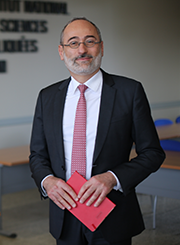
Thinking about the changing role and responsibility of engineers with our alumni
By Frédéric Fotiadu, Director of INSA Lyon
For the past two years, INSA Lyon has been engaged in a forward-looking approach, inspired by the method developed by its founding father Gaston Berger. This work has enabled us to give careful thought to the possible future of our institution up to 2040 by envisaging various scenarios, some of which are disruptive. The Covid-19 crisis brutally confronted us with these exceptional scenarios, which at the beginning of 2020 were still considered unlikely. Faced with the issues resulting from these circumstances, the question of the role of engineers, already at the heart of our forward-looking approach, remains more topical than ever.
Through the diversity of the positions they occupy in all fields and business sectors, through the infinite wealth of their career paths and personal experiences, INSA graduates are both an extraordinary source of information and inspiration, and a great sounding board for these issues. They are also, by their number, a powerful lever for the transformation of companies and organisations in our societies. I am therefore particularly happy and enthusiastic at the idea of this INSA Lyon Alumni Chair to broaden our thinking on the place and responsibility of the engineer in today's world and in the future.
This absolutely exciting project will help to strengthen the links and interactions between our institution and its alumni network. It is also a great opportunity to bring our community closer to graduates who had moved away from it. In a world in search of meaning and new points of reference, this Chair is an invitation to get us all involved in thinking about our role in society on the basis of what has been the very essence of INSA Lyon since its creation: the model of the humanist engineer.
This ‘INSA trademark’ is based precisely on the ability to open up to other disciplines, particularly the humanities and social sciences, in order to grasp the plurality of the world and always question the societal and environmental impact of technologies. It is also about opening up to the world of arts, culture and sport, to develop our thinking and experience of other forms of sensitivity, interactions, practices, other quests for performance and excelling ourselves. Finally, it is a real citizen commitment to social openness and all forms of diversity in order to build a fairer, more inclusive, caring and altruistic world.
Educated according to this model carried forward by INSA and driven by its fundamental values, our graduates are particularly able to detect the multitude of strong or weak signals that herald the changes to come. They have the ability to consider them not only from a technological point of view, but also and above all from a comprehensive intellectual approach. It is precisely this dynamic that will be implemented within the Alumni Chair, at the service of our students, our lecturers and researchers, our partners and society in general.
It will be a question of always preparing ourselves better to face this uncertain, complex future, turned upside down by the present, by adopting a systemic vision to consciously and ethically engage in the major energy, environmental and ecological, digital, but also social and societal transitions, which will allow a desirable future to emerge.
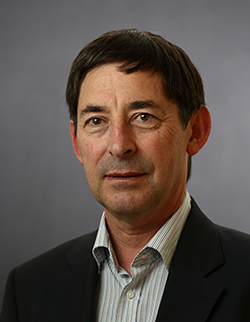 Repositioning the role of the engineer in society
Repositioning the role of the engineer in society
By Daniel Louis-André, INSA electrical engineering class of 1977 and president of the INSA Lyon Alumni Association
INSA engineers, male or female, are attached, maybe now more than ever, to all the values conveyed by the INSA model. Although their features, such as their frame of mind, have not been eroded by time, I think we can see that INSA engineers have changed a lot.
First of all, with the international dimension they have been able to gain, both in business and in wider society. Forty years ago, going on an exchange during your studies was the privilege of a few of us. Since then, mobility has become compulsory for all students and means of communication have developed considerably, making internationalisation much easier to manage.
In this world where everything has accelerated, we also see that INSA engineers are increasingly looking for meaning. Commitment, consistency with the company's values and the usefulness of the job are the driving forces in the search for employment, as well as in keeping a job. Salary is no longer enough for happiness. The model of society of recent decades is no longer dreamt of; it is even criticised. Society has to transform itself.
In my speciality, electrical engineering, engineers are aware that they are right at the heart of the transformation of the energy model. In this race towards low-emission mobility, young people are aware of a key issue: their impact on changing lifestyles to reduce energy consumption.
The environmental aspect and the place of human beings have become paramount.
In the projection of the industry of the future, from factory 4.0, amid big data, connected objects and ultra-technology, there is this path towards innovation at home, short supply chains and customised models.
Engineers will therefore be asked to be ever more creative, in a more comprehensive way. They will be asked to strike a balance between the expertise they will be able to develop with regard to cutting-edge technologies, and the need to work within a wider approach to better integrate the environmental aspect throughout the production cycle and place human beings at the heart of the processes, where they belong.
Engineers of tomorrow must play this role, have this global vision, develop this systemic approach and exercise their critical faculties more than ever. They must be able to look beyond their ‘heritage’ of skills even if it means questioning approaches that seem obvious.
Finally, I personally would like engineers to have a more important role in the city through their general knowledge and know-how, whereas today they have little impact. This is perhaps what we need to pass on to our young people: to learn not to be passive in the face of systems that lock them up in models. The role of the engineer needs to be repositioned, and my optimism leads me to believe that this is possible.
But to succeed in developing new approaches that respond both to engineers’ search for meaning and to the need to reposition their role in society, we must ask ourselves questions about the execution.
How should INSA engineers behave within the company in order to play their role? How will these engineers of tomorrow manage to play an important role in their company while casting their critical eye? How will they be able to initiate change without being seen as the ones who want to revolutionise everything? The concepts of interpersonal skills and understanding of the business world are fundamental here and must guide students’ education, beyond the scientific bases that must naturally be preserved.
I have been President of the Alumni Association since March 2019 and since then, I have been in regular contact with INSA students and graduates. With this Chair, we wish to provide answers to their concerns, particularly with regard to societal and environmental issues. And we can do it together, with the school and the INSA Lyon Foundation.
For me, this tripartite dimension is essential to the success of this project, as of many others. As alumni, we can make the link between those who think about education at INSA Lyon, working engineers and those in the making.
We wish to make this Chair a place for the exchange of ideas and experiences, which produces tangible results for all stakeholders: Schools and lecturers, working engineers and companies.
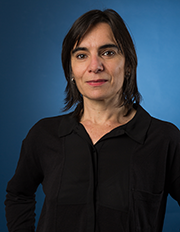 Promoting the model of the humanist engineer
Promoting the model of the humanist engineer
By Laure Corriga, Chair of the Board of INSAVALOR
We support this original Chair, which is perfectly legitimate because it sticks to the DNA of INSA Lyon. Questioning the role of the engineer is part of the school's foundations and it is important to share this reflection with our ecosystem, alongside the Alumni Association and the INSA Lyon Foundation.
For me, engineers are people who, faced with a variety of issues and problems, provide technical and organisational solutions while being aware of the impacts and stakeholders that surround them. Their great quality is their adaptability. Today, in a context where economic, societal and environmental issues are more visible, engineers are becoming players whose role should be greater, with a more prominent place in society. Their vision should be essential, driven by this project approach that they mastered through their education.
The role of the engineer is changing because society is changing. In a world that is becoming more automated, engineers will be forced to change, to take new parameters into consideration. Beyond technological innovation, they will have to measure the impact of their decisions on the societal and environmental levels and, further on, invent new models, in particular by calling on their creativity. They will have to live with change but also initiate it. They will change in a more internationalised context, with collaborations for less immediate responses.
INSA introduces its students to this aim, and wishes to provide them with the necessary knowledge and skills. From this Chair, I would like to see a sort of certification for humanist engineers, which would allow us to bear witness to the INSA career path and the comprehensive approach acquired through education.
INSAVALOR can, on a very operational level, contribute to the work of the Chair on aspects of continuing education and develop educational modules consistent with the philosophical approach taken by this Chair. Moreover, as a player in the field, we will be able to hear the expectations of companies and witness their changes. Some of them have already undertaken a fundamental rethink and have understood that they must flourish with new, more committed generations. Others are working on their employer brand and are moving in this direction.
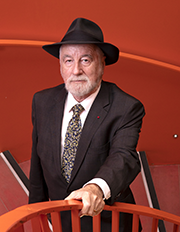
Strengthening the link between different generations of engineers by placing the very philosophy of the profession at the heart of discussions
Jean Guénard, 8th INSA civil engineering class and President of the INSA Lyon Foundation The engineer’s environment has changed since INSA was founded in 1957. For its co-founder, Gaston Berger, man was then at the centre of all concerns. Today, more than sixty years later, we can see that students defend another position: the Earth is now at the centre of their concerns. This concept of ‘Earth in danger’, which was reserved only for a few slightly marginalised elites at the time, has become omnipresent today. The concepts of frugality, repairs and savings have returned to the fore and humanist engineers have this awareness that the earth's resources are not inexhaustible. Engineers, who must henceforth think not only of themselves, must make their contribution to social, economic, intellectual and cultural change in the world around them, and in the organisation of work.
I therefore await from this Chair, with great interest, a practical and current redefinition of the concept of the humanist engineer, where we refer to man but also to the Earth. But for me, engineers of tomorrow are not, apart from this environmental aspect, so different from what they were yesterday. With excellent technique and cutting-edge expertise in their speciality, they have a solid education and an openness beyond their field of expertise, coupled with a general culture that must be as broad as possible.
For me, engineers are people who are interested in what is happening around them, and who put their skills at the service of their values. These are values with which they agree from the time of their education at INSA. These strong values were conveyed by the school when I was a student myself. I am one of those who have had access to this excellent education, even though I am far from the world of higher education. My parents, who were farmers and then grocers in Le Creusot, supported me in my schooling, which was rather satisfactory. Thanks to them, I was able to go to INSA and then benefit from a scholarship in my second year. At the time, I didn't know that I would succeed in the extraordinary feat of ending up in a career rich in dozens of works of art, civil engineering, undergrounds, railways and roads, ports and maritime works and the construction of a unique structure: the Millau Viaduct. Luck? Intuition? Audacity? Ambition? No doubt a bit of all four, but above all a taste and a developed practice of team motivation.
Alone, I am nothing. Together, everything, absolutely everything, is possible
I started out as a works manager and worked my way up through the ranks at EMCC and then Eiffage, until I became President of the Infrastructure division. In my speciality, civil engineering, we design, we build, and we can monitor the implementation. This is a field where we can look to the future. Today, the need for new infrastructure is no longer as strong, and the time has come to renew the heritage and carry out preventive maintenance on buildings. It's a real challenge for engineers in my speciality to deal with what already exists. Thanks to this Chair, driven by the alumni, the link between different generations of engineers will be strengthened, by placing the very philosophy of the profession at the heart of discussions. And, again, I hope to make the unthinkable possible.
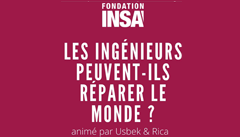
Sciences & Société
Can engineers fix the world?
An event hosted by the INSA Foundation in partnership with Vinci.
Change of venue, meet at => Lecture theatre AE2 in the Gustave Ferrié building - Electrical Engineering Department.
A debate moderated by Usbek & Rica with the participation of:
- Océane Lannoy, fifth-year SGM (Materials Science and Engineering) student and member of the association Ingénieur(e)s Engagé(e)s Lyon
- Gaétan Lepoutre, co-founder of Les Détritivores Lyon - Les Alchimistes Lyon
- Thierry Covelo, Director of HR Development and Diversity at Vinci
Additional informations
-
𝗔𝗺𝗽𝗵𝗶 𝗔𝗘𝟮 𝗱𝘂 𝗯𝗮̂𝘁𝗶𝗺𝗲𝗻𝘁 𝗚𝘂𝘀𝘁𝗮𝘃𝗲 𝗙𝗲𝗿𝗿𝗶𝗲́ - 𝗜𝗡𝗦𝗔 𝗟𝘆𝗼𝗻.
Keywords (tags)
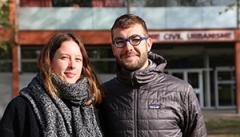
Formation
Quand l’ingénieur rencontre l’architecte
Les 23 et 24 mars derniers à Saint-Étienne, Charlotte Lovage et Vincent Jackow ont fait partie des équipes qui représentaient l’INSA Lyon au Bridge Challenge, un concours invitant étudiants ingénieurs et architectes à réaliser des maquettes de ponts. L'occasion pour ces deux étudiants en double diplôme ingénieur-architecte de revenir sur les différences de perception entre les deux métiers.
La tête dans les nuages ou les pieds sur terre
Il y a quelques siècles, les métiers d’ingénieur et d’architecte ne formaient qu’un. La séparation en deux domaines distincts est née au fur et à mesure des évolutions urbaines, et l’apparition des chemins de fer a naturellement renforcé l’opposition : les ingénieurs étaient au service du territoire et les architectes au service de la demande particulière. Les premiers faisaient des infrastructures et des réseaux au moyen des sciences quand les seconds imaginaient des palais pour répondre à une forme de « spiritualité matérielle ».
« Peut-être qu’en entrant dans le monde du travail, on trouvera une autre réalité. Pour le moment, on ressent une sorte de scission. Nous sommes catalogués ‘architectes’ par nos camarades ingénieurs et nous sommes des ingénieurs GCU (Génie Civil et Urbanisme) pour nos camarades architectes » explique Vincent.
Charlotte et Vincent semblent être avertis et conscients des clichés qui collent aux deux professions.
« L’architecte a la tête dans les nuages et l’ingénieur les pieds sur terre. Et il faut avouer qu’il y a une certaine forme de réalité derrière ces stéréotypes. En tant qu’élèves ingénieurs-architectes, nous le ressentons et nous l’incarnons malgré nous ! Mon côté ‘archi’ me fera dessiner un pont de plusieurs mètres qui ne tient sur rien, mais mon côté ‘ingé’ me fera vérifier que ça peut tenir ou pas. L’un a une démarche davantage artistique quand l’autre a une démarche plus rationnelle » précise Charlotte.
La relation professionnelle entre l’ingénieur et l’architecte peut donc parfois rimer avec frustration et conflits d’intentions, cependant, comme l’illustre le Viaduc de Millau qui a réuni l’ingénieur Michel Virlogeux et l’architecte britannique Norman Foster, lorsque la collaboration est harmonieuse, les ouvrages sont grandioses.
« Si je diffère de toi, loin de te léser, je t’augmente1 »
Les deux étudiants s’accordent pour parler de barrières de communication entre ingénieurs et architectes.
« Les mêmes mots ne veulent pas dire la même chose chez les uns et les autres ! Et certains concepts n’existent pas chez les ingénieurs, comme ‘la charrette’. La charrette, c’est la nuit blanche dont l’architecte a besoin pour finir son projet dans les délais parce qu’il a trop rêvé et chez les ingénieurs, il n’y en a pas car tout est calculé au millimètre près ! » rit Vincent.
Deux points de vue qui semblent se confronter en théorie, mais les visions des deux disciplines se complétent en réalité.
« L’architecte travaille un ensemble de structure. Il porte sa réflexion sur l’espace, la lumière ou les volumes. L’ingénieur identifie des contraintes et cherche à les résoudre au moyen de solutions techniques » explique Charlotte.
Le double diplôme ingénieur-architecte : un pont qui facilite la
communication ?
À l’INSA Lyon, une quarantaine d’étudiants suivent le double diplôme ingénieur-architecte. Un cursus en sept ans, entre l’INSA et l’ENSAL, l’École Nationale Supérieure d’Architecture de Lyon, qui ouvre l’horizon professionnel comme l’expliquent les deux étudiants.
« Nous savons qu’il faudra faire un choix entre les deux métiers à la sortie du diplôme, mais c’est une réelle liberté d'avoir le choix et se laisser guider par les opportunités. »
Même si le choix n’est pas encore fait pour Charlotte et Vincent, chacun nourrit l’espoir d’incarner la clé de voûte d’un dialogue plus ouvert entre les deux corps de métier.
« Peut-être qu’en tant que futurs ingénieurs-architectes, nous sommes des éléments intéressants à une meilleure compréhension entre les deux mondes ! »
Parmi les quatre équipes représentant l’INSA au concours, deux ont été récompensées.
Le troisième prix d’architecte a été décerné à l’équipe de Bastien Bordas, Quentin Sola, Florian Bonfill et Jean-paul De Grandchamt et le prix Cobaty à l’équipe de Sara Hassani Idrissi, Clémence Thiriot, Andrew Ahpo et Samuel Grelier. Félicitations à eux !
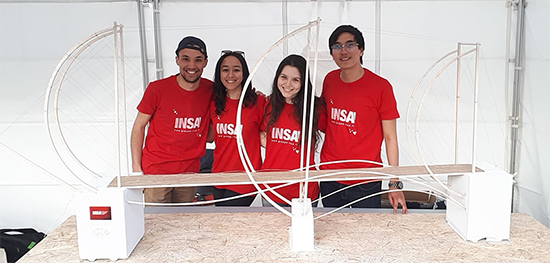
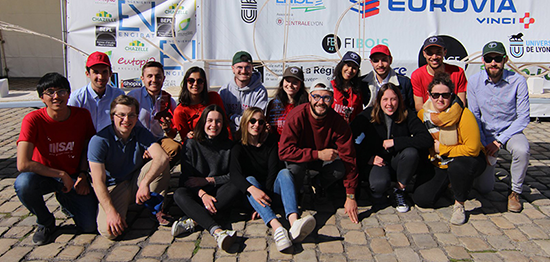
1 Antoine de Saint-Exupéry, « Lettre à un otage » (1943)

Recherche
L’Antarctique, le nouvel eldorado de Raphaël Gilly
Après avoir vécu toute son enfance sous le soleil de Provence, passé cinq années à l’INSA Lyon, décroché son diplôme d'ingénieur 2018, Raphaël Gilly a décidé d’entreprendre une folle aventure en postulant à une mission hors du commun à l’Institut Polaire Français (ou IPEV pour Institut Paul Émile Victor). Il raconte son périple.
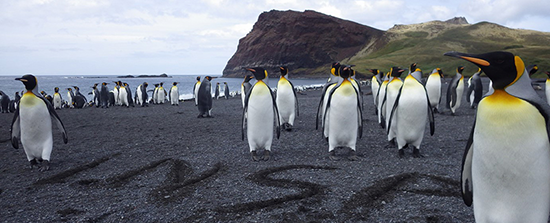
Manchots dans leur habitat naturel - © Raphaël Gilly
Un parcours sans embûches
J’ai toujours voulu travailler dans les domaines de la science et de l’ingénierie. Je cherchais un établissement où côtoyer des gens de tous horizons, avec la possibilité de partir à l’étranger tout en proposant un campus à taille humaine. C’est tout naturellement que je me suis intéressé à l’INSA. Après mes deux premières années de formation, je me suis orienté vers le département Télécommunications, Services et Usages (TC) qui est particulièrement généraliste et qui m’a ouvert les portes d’une première expérience à l’international, avec un échange à Shanghai.
Pendant ces cinq ans de vie sur le campus, j’ai également pris part à la vie associative. J’ai fait partie de l’association aérospatiale de l’INSA (CLES-FACIL), où notre objectif a été de lancer une fusée dans l’atmosphère, tout en étant encadré par le Centre National d’Études Spatiales (CNES). Je me suis également impliqué dans la Troupe Théâtrale de l’INSA (TTI), à la fois en improvisation et en écriture. J’ai même eu la chance de mettre en scène une pièce de théâtre, c’est l’un des souvenirs les plus forts de mes années insaliennes !
En route pour l’Antarctique
Passionné par les voyages en tout genre, j’ai toujours voulu découvrir de nouvelles cultures ou de nouvelles façons de vivre. C’est dans cette optique que j’ai postulé à la mission de l’IPEV. Elle regroupe à la fois la science et la vie en milieu isolé. Ça m’a tout de suite plu.
Tous les ans, les sélections pour intégrer cette base sub-antarctique se font de janvier à juin pour un départ prévu en novembre. Il y a plusieurs entretiens, dont un plus orienté technique, puis des examens de connaissances générales. Là, j’avoue que mes cours de conception m’ont bien aidé. Ensuite, il faut encore passer des examens médicaux et des tests psychologiques.
Plusieurs mois après ma première candidature, me voilà retenu pour intégrer la base sub-antarctique ! Ce qui a fait la différence, ce sont les soft-skills, ces compétences en savoir-être que l’on oublie souvent en bas de notre CV. Pourtant, ce sont bien nos capacités de vie en communauté qui vont faire la différence dans ces milieux.
Un observatoire unique au monde
L’IPEV est une agence qui soutient les programmes de recherche dans les terres australes et antarctiques françaises. Ces territoires constituent la plus grande réserve naturelle de France, elles regroupent la Terre Adélie (sur la côte du Pôle Sud), les îles Amsterdam et Saint Paul, l’archipel de Kerguelen, et l’archipel de Crozet, où je suis actuellement. Les régions antarctique et sub-antarctique sont un observatoire unique au monde pour l’étude des changements climatiques et leur évolution.
En France, on a du mal à se rendre compte de l’impact que nous avons sur l’environnement alors qu’ici c’est flagrant. Nous voyons directement les conséquences des activités humaines sur la nature : la pollution en augmentation, la fragilité de la terre, les dégâts causés par les espèces introduites comme les rats par exemple…
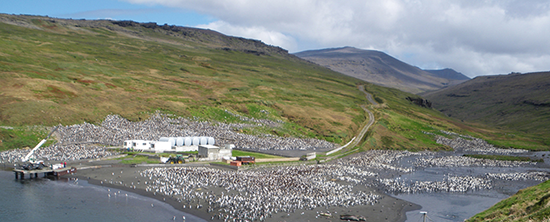
Archipel de Crozet - © Christophe Guillerm
Des missions passionnantes
Depuis mon arrivée sur cette base, je participe à plusieurs programmes de recherche qui touchent à des domaines variés. Nous réalisons notamment des relevés quotidiens de données sismologiques et sur le champ magnétique de la Terre, dans le cadre des observatoires de l’École et Observatoire des Sciences de la Terre. Nous travaillons également avec l’Agence Spatiale Française pour des programmes de positionnement de satellites, et aussi avec l’Agence Américaine d’Observation Océaniques et Atmosphériques pour qui nous analysons la pollution de l’air. Toutes ces missions m’ont montré l’avantage d’avoir suivi ma formation à l’INSA. Grâce à mes cinq ans d’études, je suis un touche à tout !
Le mot de la fin pour les insaliens
J’encourage tous les élèves-ingénieurs à postuler à ce type de mission. Il ne faut pas avoir peur, il faut tenter pour ne rien regretter. L’objectif n’est pas de se fermer des portes mais de réaliser ses rêves !
Podcasts « Les cœurs audacieux » - Saison 2 / Épisode 4 - 10 mars 2022
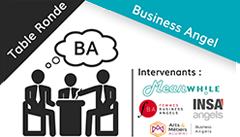
Sciences & Société
Ingénieur et Business Angel
Une table ronde proposée par un groupe de 7 étudiants en 5e année au département Génie Industriel.
En quoi le profil d’ingénieur peut-il représenter un avantage dans l’activité de Business Angel ?
L'audience de la table ronde est ouverte à l’ensemble des étudiants de l’INSA Lyon, notamment les élèves ingénieurs du département génie industriel.
Seront abordés les questions suivantes :
- Qu'est ce qu'un Business Angel (ses enjeux, ses compétences, les risques liés à l’activité, etc) ?
- L'intérêt d'un ingénieur à devenir Business Angel L'intérêt d’avoir un Business Angel ingénieur dans une entreprise ?
- Le jeune ingénieur est-il formé pour devenir Business Angel ?
- Les femmes dans le rôle de Business Angel
Les intervenants présents : Françoise Nauts (Femme business angel), Sacha Stojanovic (Fondateur de Meanwhile), Gilles Assolant (INSA Angels) & plus à venir
Inscription non obligatoire mais conseillée => https://goo.gl/forms/DH2aGB0p1EshMcNi2
Additional informations
- geoffrey.buisan@insa-lyon.fr
-
Amphithéatre EST, Centre des Humanités, Campus LyonTech-La Doua, 1 rue des Humanités Villeurbanne 69100


